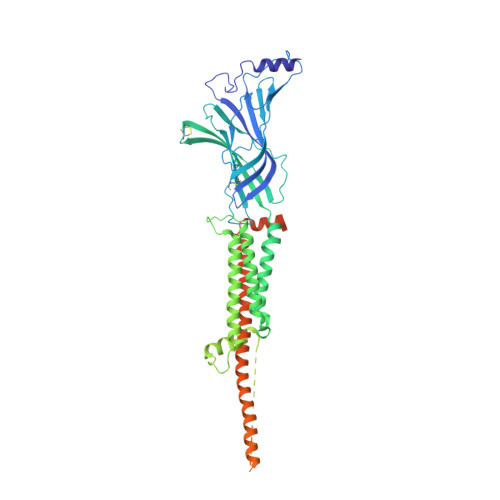Structural mechanisms of alpha 7 nicotinic receptor allosteric modulation and activation.
Burke, S.M., Avstrikova, M., Noviello, C.M., Mukhtasimova, N., Changeux, J.P., Thakur, G.A., Sine, S.M., Cecchini, M., Hibbs, R.E.(2024) Cell 187: 1160-1176.e21
- PubMed: 38382524
- DOI: https://doi.org/10.1016/j.cell.2024.01.032
- Primary Citation of Related Structures:
8UT1, 8UTB, 8UZJ, 8V80, 8V82, 8V86, 8V88, 8V89, 8V8A, 8V8C, 8V8D - PubMed Abstract:
The α7 nicotinic acetylcholine receptor is a pentameric ligand-gated ion channel that plays an important role in cholinergic signaling throughout the nervous system. Its unique physiological characteristics and implications in neurological disorders and inflammation make it a promising but challenging therapeutic target. Positive allosteric modulators overcome limitations of traditional α7 agonists, but their potentiation mechanisms remain unclear. Here, we present high-resolution structures of α7-modulator complexes, revealing partially overlapping binding sites but varying conformational states. Structure-guided functional and computational tests suggest that differences in modulator activity arise from the stable rotation of a channel gating residue out of the pore. We extend the study using a time-resolved cryoelectron microscopy (cryo-EM) approach to reveal asymmetric state transitions for this homomeric channel and also find that a modulator with allosteric agonist activity exploits a distinct channel-gating mechanism. These results define mechanisms of α7 allosteric modulation and activation with implications across the pentameric receptor superfamily.
- Molecular Biophysics Graduate Program, University of Texas Southwestern Medical Center, Dallas, TX 75390, USA; Department of Neurobiology, University of California, San Diego, La Jolla, CA 92093, USA.
Organizational Affiliation:























